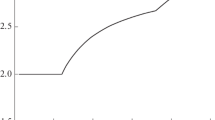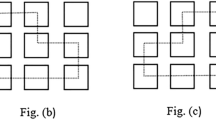Abstract
A new class of binary low-density parity-check (LDPC) codes is proposed based on B2(mod m) sequences. The parity-check matrix of such a code has a column weight of three and a row weight of an arbitrary integer, and a quasi-cyclic structure. The parity-check matrix also has a girth at least 8, and corresponds to a code with minimal distance at least 12. When m is prime, an 8-cycles reduction method is presented to completely avoid the two types of 8-cycles within the total four types existed in the Tanner graph. Simulation results show that, for a prime integer m, the new LDPC code outperforms the random (quasi-) regular counterpart generated by the PEG algorithm. Finally, a heuristic algorithm based on a strategy called neighboring extension search is presented to search for the B2(mod m) sequences whose lengths approach or meet the upper bound.
Similar content being viewed by others
References
MacKay D J C, Neal R M. Near Shannon limit performance of low density parity check codes. IEE Electron Lett, 1997, 33: 457–458
Hu X Y, Eleftheriou E, Arnold D M. Regular and irregular progressive edge-growth Tanner graphs. IEEE Trans Inf Theory, 2005, 51: 386–398
Kou Y, Lin S, Fossorier M P C. Low-density parity-check codes based on finite geometries: a rediscovery and new results. IEEE Trans Inf Theory, 2001, 47: 2711–2736
Lan L, Zeng L Q, Tai Y Y, et al. Construction of quasi-cyclic LDPC codes for AWGN and binary erasure channels: a finite field approach. IEEE Trans Inf Theory, 2007, 53: 2429–2458
Fossorier M P C. Quasi-cyclic low-density parity-check codes from circulant permutation matrices. IEEE Trans Inf Theory, 2004, 50: 1788–1793
Xu J, Chen L, Zeng L Q, et al. Construction of low-density parity-check codes by superposition. IEEE Trans Commun, 2005, 53: 243–251
Hu X Y. Low-delay low-complexity error-correcting codes on sparse graphs. PhD Thesis, Switzerland, Swiss Federal Institute of Technology Lausanne (EPFL), 2002
Dimitromanolakis A. Analysis of the Golomb ruler and the Sidon set problems, and determination of large, near-optimal Golomb rulers. PhD Thesis. Chanic: Technical University of Crete, 2002
Ge X, Xia S T. Structured non-binary LDPC codes with large girth. IEE Electron Lett, 2007, 43: 1220–1221
O’Bryant K. A complete annotated bibliography of work related to Sidon sequences. Electron J Combin, 2004, #DS11: 1–39
Milenkovic O, Kashyap N, Leyba D. Shortened array codes of large girth. IEEE Trans Inf Theory, 2006, 52: 3707–3722
Hu X Y, Eleftheriou E, Arnold D M. Progressive edge-growth Tanner graphs. In: Proc IEEE Global Telecommun Conf, San Antonio, Texas, USA, 2001. 995–1001
Author information
Authors and Affiliations
Corresponding author
Rights and permissions
About this article
Cite this article
Zhang, G., Wang, X. A class of quasi-cyclic LDPC codes from B2(mod m) sequences. Sci. China Inf. Sci. 54, 1645–1653 (2011). https://doi.org/10.1007/s11432-011-4305-9
Received:
Accepted:
Published:
Issue Date:
DOI: https://doi.org/10.1007/s11432-011-4305-9




